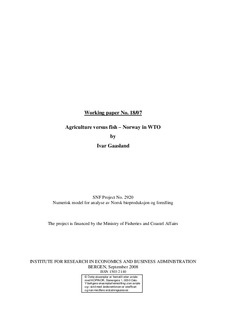| dc.contributor.author | Gaasland, Ivar | |
| dc.date.accessioned | 2009-05-04T10:56:14Z | |
| dc.date.available | 2009-05-04T10:56:14Z | |
| dc.date.issued | 2008-09 | |
| dc.identifier.issn | 1503-2140 | |
| dc.identifier.uri | http://hdl.handle.net/11250/166214 | |
| dc.description.abstract | The Norwegian agriculture is highly protected and subsidised. The opposite is the case for fisheries and fish farming which suffer from foreign market restrictions. Using a computational general equilibrium model, the gain for Norway of a complete elimination of food subsidies and tariffs is estimated to be in the range of 1.2 - 2.7 per cent of GDP. Most of this gain stems from domestic farm sector liberalisation. The gain from free market access for seafood is estimated to 4.4 per cent of the seafood export value. Consequently, Norway has much to gain from offering other countries market access for agricultural products. In return, Norway should demand free access for their fish products. | en |
| dc.language.iso | eng | en |
| dc.publisher | SNF | en |
| dc.relation.ispartofseries | Working paper | en |
| dc.relation.ispartofseries | 2007:18 | en |
| dc.subject | general equilibrium model | en |
| dc.subject | cost of agricultural policy | en |
| dc.subject | trade liberalisation | en |
| dc.subject | food industry | en |
| dc.subject | fisheries | en |
| dc.title | Agriculture versus fish – Norway in WTO | en |
| dc.type | Working paper | en |
| dc.subject.nsi | VDP::Landbruks- og Fiskerifag: 900::Fiskerifag: 920 | en |
